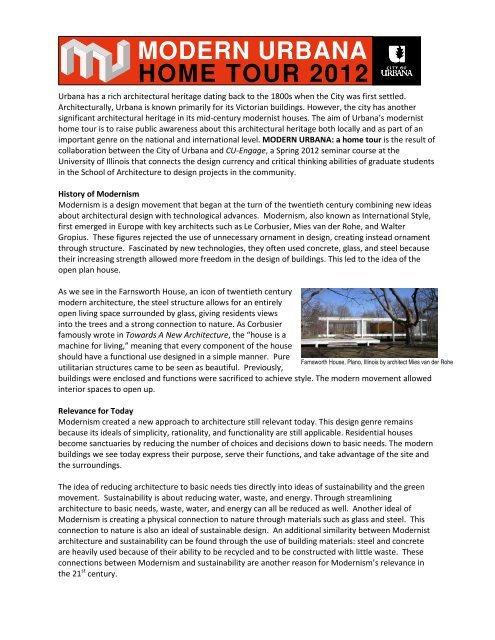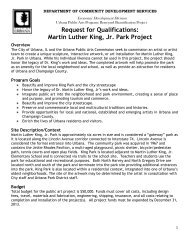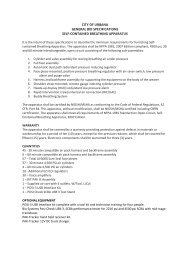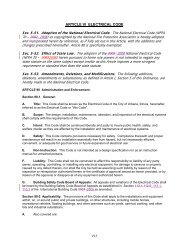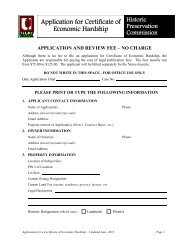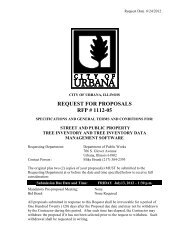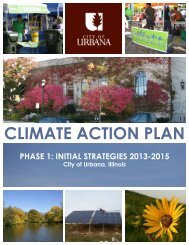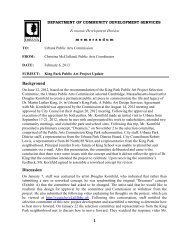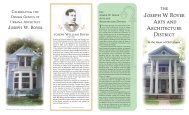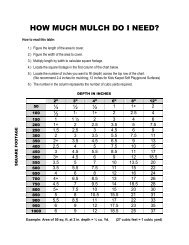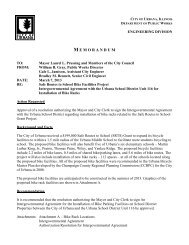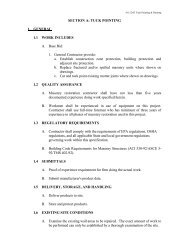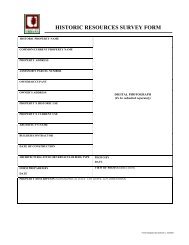MODERN URBANA Home Tour Statement - City of Urbana
MODERN URBANA Home Tour Statement - City of Urbana
MODERN URBANA Home Tour Statement - City of Urbana
You also want an ePaper? Increase the reach of your titles
YUMPU automatically turns print PDFs into web optimized ePapers that Google loves.
<strong>Urbana</strong> has a rich architectural heritage dating back to the 1800s when the <strong>City</strong> was first settled.Architecturally, <strong>Urbana</strong> is known primarily for its Victorian buildings. However, the city has anothersignificant architectural heritage in its mid-century modernist houses. The aim <strong>of</strong> <strong>Urbana</strong>’s modernisthome tour is to raise public awareness about this architectural heritage both locally and as part <strong>of</strong> animportant genre on the national and international level. <strong>MODERN</strong> <strong>URBANA</strong>: a home tour is the result <strong>of</strong>collaboration between the <strong>City</strong> <strong>of</strong> <strong>Urbana</strong> and CU-Engage, a Spring 2012 seminar course at theUniversity <strong>of</strong> Illinois that connects the design currency and critical thinking abilities <strong>of</strong> graduate studentsin the School <strong>of</strong> Architecture to design projects in the community.History <strong>of</strong> ModernismModernism is a design movement that began at the turn <strong>of</strong> the twentieth century combining new ideasabout architectural design with technological advances. Modernism, also known as International Style,first emerged in Europe with key architects such as Le Corbusier, Mies van der Rohe, and WalterGropius. These figures rejected the use <strong>of</strong> unnecessary ornament in design, creating instead ornamentthrough structure. Fascinated by new technologies, they <strong>of</strong>ten used concrete, glass, and steel becausetheir increasing strength allowed more freedom in the design <strong>of</strong> buildings. This led to the idea <strong>of</strong> theopen plan house.As we see in the Farnsworth House, an icon <strong>of</strong> twentieth centurymodern architecture, the steel structure allows for an entirelyopen living space surrounded by glass, giving residents viewsinto the trees and a strong connection to nature. As Corbusierfamously wrote in Towards A New Architecture, the “house is amachine for living,” meaning that every component <strong>of</strong> the houseshould have a functional use designed in a simple manner. Pureutilitarian structures came to be seen as beautiful. Previously,buildings were enclosed and functions were sacrificed to achieve style. The modern movement allowedinterior spaces to open up.Farnsworth House, Plano, Illinois by architect Mies van der RoheRelevance for TodayModernism created a new approach to architecture still relevant today. This design genre remainsbecause its ideals <strong>of</strong> simplicity, rationality, and functionality are still applicable. Residential housesbecome sanctuaries by reducing the number <strong>of</strong> choices and decisions down to basic needs. The modernbuildings we see today express their purpose, serve their functions, and take advantage <strong>of</strong> the site andthe surroundings.The idea <strong>of</strong> reducing architecture to basic needs ties directly into ideas <strong>of</strong> sustainability and the greenmovement. Sustainability is about reducing water, waste, and energy. Through streamliningarchitecture to basic needs, waste, water, and energy can all be reduced as well. Another ideal <strong>of</strong>Modernism is creating a physical connection to nature through materials such as glass and steel. Thisconnection to nature is also an ideal <strong>of</strong> sustainable design. An additional similarity between Modernistarchitecture and sustainability can be found through the use <strong>of</strong> building materials: steel and concreteare heavily used because <strong>of</strong> their ability to be recycled and to be constructed with little waste. Theseconnections between Modernism and sustainability are another reason for Modernism’s relevance inthe 21 st century.
Modernism in the Local ContextFollowing World War II, returning soldiers fueled the demand for affordable housing in Illinois. TheChicago area, <strong>of</strong>ten called the birthplace <strong>of</strong> Modernism in America due to the influence <strong>of</strong> Mies van derRohe at the Illinois Institute <strong>of</strong> Technology and Frank Lloyd Wright in Oak Park, enjoyed a robust period<strong>of</strong> mid-century residential building during this time. <strong>Urbana</strong>, like other downstate communities, was nota booming city for architectural construction during this time.The University <strong>of</strong> Illinois at <strong>Urbana</strong>-Champaign, however, made an impact on architectural modernism inthis region. During the mid-century time period, the University’s College <strong>of</strong> Fine and Applied Artsespoused an integrative approach to architectural design and arts and was fortunate to bring threeexceptionally gifted designers to the area as faculty: Jack Sherman Baker, A. Richard Williams, and JohnG. Replinger. This group is responsible for the majority <strong>of</strong> modernist homes in the city <strong>of</strong> <strong>Urbana</strong>. Aseducators and pr<strong>of</strong>essional architects, they confronted the contemporary architectural context. Theyfocused on achieving design solutions through the use <strong>of</strong> materials, sites, spatial organizations, andnumerous other considerations unique to central Illinois. Their settlement in <strong>Urbana</strong>-Champaign was asignificant influence on bringing modernist architecture to central Illinois.Selection ProcessAs a first step in the selection <strong>of</strong> homes for the <strong>MODERN</strong> <strong>URBANA</strong> home tour was to search for homesbuilt between 1950 and 1970 in <strong>Urbana</strong>. While the style <strong>of</strong> Modernism extends from the early 1920’sinto today, this 20-year mid-century range best represents the period <strong>of</strong> construction closely tied withthe post-war residential housing period. We looked for houses that translate well the Modernistaesthetic in terms <strong>of</strong> materials, simple geometries, lack <strong>of</strong> ornamentation, and open floor plans. Usingexisting research from current University faculty, interviews with local architects, and city records, weformed a list <strong>of</strong> Modernist homes in <strong>Urbana</strong>. Our research returned an impressive number <strong>of</strong> homes,nearing 40 that fit the criteria. We then went about the task <strong>of</strong> conducting a design inventory – lookingat home condition, location, and design – in order to conceive <strong>of</strong> the best possible collection <strong>of</strong> homesto include on the tour.The <strong>Tour</strong>The collection <strong>of</strong> homes on the tour reflects the selection process above as well as their accessibility,proximity to one another, and parking availability. All the homes are bonded by their modernistaesthetic. The most noticeable common characteristics in these homes are the use <strong>of</strong> transparenciesand natural materials such as wood, the relationship between indoor and outdoor, and simple geometrywith open floor plans. All the homes express these commonalities differently. Some have attachedgarages and some have carports. More contrasts include gable versus flat ro<strong>of</strong>s. Most <strong>of</strong> the houses onthe tour open to face the sun and landscaping in the back gardens by using floor-to-ceiling windows. Bycontrast, the fronts <strong>of</strong> some <strong>of</strong> these homes have a private front entry with minimal windows. Othershave a good openness with high transparency in the front entrance. These characteristics are found inRichard William’s and John Replinger’s designs by creating a brick wall at the main entrance and makinga private outdoor area. On the other hand, Bruce G<strong>of</strong>f uses big windows in the front <strong>of</strong> his design,creating transparency.As a collection, the houses show a sampling <strong>of</strong> the mid-century modernist style homes, while alsoproviding contrasts in the specifics <strong>of</strong> this design genre. They provide a framework for discussion aboutmodernism regionally, and about the mid-century post war housing movement in the United States. It isour hope that this tour will serve to inspire and educate, and help you get to know our city, <strong>Urbana</strong>, justa bit better.


